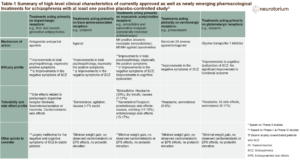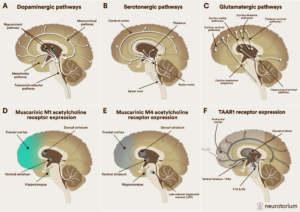M4 receptors are presynaptic autoreceptors, and their stimulation inhibits acetylcholine release from the hindbrain to the ventral tegmental area in the midbrain. This reduced acetylcholine transmission reduces M5 receptor stimulation-related presynaptic dopamine synthesis in the associative striatum, where recent human evidence suggests that hyperdopaminergia is related to psychosis. Additionally, M4 autoreceptor agonism in the nucleus accumbens leads to reduced cholinergic interneuron stimulation of dopamine release and transmission in the associative striatum. Finally, M1 receptors are located postsynaptically in the frontal cortex and the hippocampus, among other brain areas. Stimulation of M1 receptors leads to the release of acetylcholine in the frontal cortex and the hippocampus, which can improve cognition. Stimulation of M1 receptors in layer II/III of the frontal cortex, however, increases acetylcholine, which in turn stimulates the inhibitory GABAergic interneuron. GABAergic stimulation then decreases glutamatergic transmission in layer V into the striatum, thereby reducing dopamine synthesis and transmission in the associative striatum.1,2
Read more about Novel and Emerging Pharmacologic Treatments for Schizophrenia





